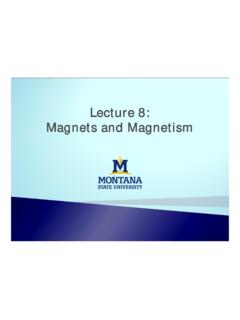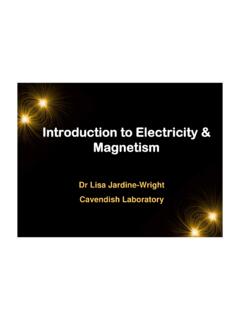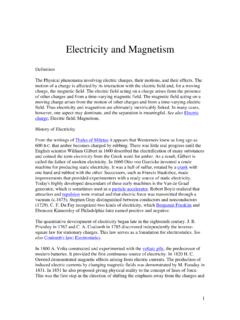Transcription of Curie Temperature - University of Oklahoma
1 Curie TemperatureNeil McGlohon & Nathan Beck (2012)Tim Corbly & Richard Mihelic (2013)The Curie Point Curie point, also called Curie Temperature , Temperature at which certain magnetic materials undergo a sharp change in their magnetic properties. This Temperature is named for the French physicist Pierre Curie , who in 1895 discovered the laws that relate some magnetic properties to change in Temperature . At low temperatures, magnetic dipoles are aligned. Above the Curie point, random thermal motions nudge dipoles out of example of a Curie pendulum which utilizes the effects of heat on a ferromagnetic substance s magnetization.
2 The motion is periodic and follows the heating/cooling process of the swinging Pendulum The heat engine uses a principle of magnetism discovered by Curie . He studied the effects of Temperature on magnetism . Ferromagnetism covers the field of normal magnetism that people typically associate with magnets. All normal magnets and the material that are attracted to magnets are ferromagnetic materials. Pierre Curie discovered that ferromagnetic materials have a critical Temperature at which the material loses their ferromagnetic behavior. This is known as its Curie Point.
3 Once the material reaches the Curie Point, it will lose some of its magnetic properties until it cools away from the heat source and regains its magnetic properties. It is then pulled into the heat source again by the engine magnet to cycle through heat source could be a flame or even a light depending on the material of the Engines A heat engine transfers energy from a hot reservoir to a cold reservoir, converting some of it into mechanical work. No engine operating between two heat reservoirs can be more efficient than a Carnot engine operating between the same reservoirs.
4 Examples of heat engines: Curie point Stirling Engine Steam engine Elastic engineNSScissor LiftTea CandleVariable Length Plumb Rod (non ferromagnetic preferably)Neodymium MagnetDiagram of ApparatusHow it works!H: magnetic field intensityM: magnetizationHow it works!1: Bob is cool, but is heating up2: Bob is Hot, It is losing its magnetization4: Bob is cool, regaining its magnetization3: Bob is Hot, but is cooling downCarnot Cycle PV DiagramOur heat engine is not exactly a Carnot cycle, however there are similarities between it and our HM vs. Ferromagnetism Materials are made up of magnetic domains, which contain atomic dipoles coupled together in some direction.
5 Typically, these domains are aligned in random directions, and so there is no overall magnetic direction. In the presence of a magnetic field, domains parallel to the field grow while others shrink. Paramagnetic materials have a positive magnetic susceptibility. Ferromagnetic materials have a strong positive susceptibility. Ferromagnetic materials can remain magnetized after the external field is Curie PointData from F. Keffer, Handbuch der Physik, 18, pt. 2, New York: Springer Verlag, 1966 and P. Heller, Rep. Progr. Phys., 30, (pt II), 731 (1967) Gadolinium has a Curie Temperature of 293 K.
6 This is equivalent to around 20 degrees Celsius. This makes for a good material in a light based Curie s Curie point is 627 K, this is equivalent to around 354 degrees Celsius. This make it optimal for a flame based Curie of Interest Nickel has a Curie Temperature of 627K. We expect the bob to follow an oscillatory path that orbits the Curie point with a period under 10 seconds (from observation of examples).Horizontal distance from flame:Source: Temperature ProfileNeodymium MagnetsCould we damage the magnet itself with the flame?We could, if the magnet crosses its Curie point, it will permanently lose its magnetization.
7 But from the flame profile in the previous slide the magnet is kept at a safe enough horizontal distance to avoid damage. The magnet stayed cool enough to touch throughout the of Basic ApparatusMark IPeriod of about 7 IIPeriod of about 5 seconds. Energy radiated by a blackbody radiator per second per unit area is proportional to the fourth power of the absolute Temperature and is given by the Stefan Boltzemann Law: But not every radiator is ideal in which case the proportionality constant for emissivity is introduced:(ideal radiator: e= 1)PA T4PA e T4 Stefan-Boltzmann Law - Cooling If the hot object is radiating energy to its cooler surroundings at Temperature Tsthen the total energy radiated is.
8 Our concern with this is the candle soot that builds up on the pendulum bob could affect the emissivity of the nickel and change the properties of the system over e A(T4 Ts4)Stefan-Boltzmann Law - CoolingData - Magnetic FieldMeasurements with a magnetic field probe, output a voltage corresponding to two different sweet spots that measured the Axial and Transverse potential at a given 1, the position of the bob when it is at its maximum magnetic field 2, the position of the bob after it falls from the distance: Horizontal distance from edge of magnet .
9 Positive distance: vertical distance from center of magnet . Positive Data - Temperature Optimally we would have spot welded a thermocouple to the bob to measure its Temperature at the different spots. This would allow us to have a definitive number for the amount of work we have harvested from the issues: The thermocouple is not without mass, this could affect how the bob interacts with the magnet , change the period, etc. The Thermocouple may be ferromagnetic itself and have a different Curie point than that of the bob, this could alter how the magnet interacts with the bob as How can we benefit?
10 Hopes: To make a more efficient heat engine. Optimally we would have a ferromagnetic pendulum bob with a non ferromagnetic, non conducting swing rod. Use a Ratchet system to take energy out Concerns: The soot from the candle can effect the cooling and heating rate of the bob. The candle flame is not stable The current pendulum rod is both conducting and ferromagnetic. Due to the geometry of the bob, there are two nodes that it can stably reside in. For the most part during operation, it prefers the lower of the two, which is Improvements Mark III Rotary Curie EngineNSExamples of Rotary TypeAluminum disk with individual nickel loopsAluminum disk with a continuous nickel loopExample of Rotary Curie EngineThe period of this engine was approximately 1 rotation every 5 seconds at an average of 16 C outside Temperature .









